Definition
Winter months in Louisiana (December, January, and February) have average seasonal temperatures ranging from the mid-40s over northern Louisiana to the low 50s across southern parishes. While average seasonal temperatures remain above the freezing mark statewide, cold fronts extending from Canada through the state occur at least once during most winters. Severe winter weather in Louisiana consists of freezing temperatures and heavy precipitation, usually in the form of rain, freezing rain, or sleet, but sometimes in the form of snow. Severe winter weather affects all but the extreme coastal margins of the state.
Because severe winter storm events are relatively rare in Louisiana, occurrences tend to be very disruptive to transportation and commerce.
Severe winter weather within the City, as indicated by activation of the City of New Orleans Freeze Plan, can be defined as when the outside temperature or wind chill reaches a sustained temperature of 35 degrees or below for more than 4 hours.
The wind chill temperature is how cold people and animals feel when outside. The wind chill is based on the rate of heat loss from exposed skin caused by wind and cold. As the wind increases, it draws heat from the body, driving down skin temperature and eventually lowering the internal body temperature. The updated Wind Chill Formula was implemented in 2001. The new formula uses advances in science, technology, and computer modeling to provide a more accurate, understandable, and useful formula for calculating the dangers from winter winds and freezing temperatures.
Table 31: Average Temperatures with Days Below 32 Degrees in Planning Area, 2019
| Month |
Average Temp (F°) |
Days per Month Below 32° |
| January |
54.5 |
0 |
| February |
65.1 |
0 |
| March |
63.2 |
0 |
| April |
70 |
0 |
| May |
79.6 |
0 |
| June |
84.1 |
0 |
| July |
84.3 |
0 |
| August |
85.5 |
0 |
| September |
85.3 |
0 |
| October |
75.5 |
0 |
| November |
60.6 |
0 |
| December |
59.6 |
0 |
| Annual |
72.3 |
0 |
Source: National Weather Service Forecast Office, New Orleans/Baton Rouge, LA
Location and Extent of the Winter Weather Hazard
Nearly the entire United States is considered at some risk for severe winter storms.
While Louisiana is far less likely to have heavy snow and ice accumulation than most other states in the United States, winter storms or conditions of ice, snow, or dangerous wind-chill factors occur at least once a year. According to data from NOAA’s NCEI database, Louisiana is in the lowest category of probable snow depth of any State with 0 – 1-inch snow depth, with a 5-percent chance of being equaled or exceeded in any given year. Louisiana winter storms that have had severe consequences for the State have generally delivered between 1 and 3 inches of ice accumulations.
Because there is no defined geographic boundary for winter storms, all people and property in New Orleans are exposed to the risk of damage from these severe weather hazards. Temperatures in New Orleans usually dip to the mid-teens in any given year. The maximum depth of snow that New Orleans would expect would be about 2 inches.
All people and assets are considered to have the same degree of exposure to winter weather. Certain populations – mainly the homeless and those with poor access to heat or utilities – are at additional risk, as are some types of infrastructure, such as pipes, and to a lesser degree, electrical services.
Severity of Winter Storms
Because severe winter storms are relatively rare in Louisiana, occurrences tend to be very disruptive to transportation and commerce. Trees, cars, roads, and other surfaces develop a coating or glaze of ice, making even small accumulations of ice an extreme hazard to motorists and pedestrians. The most prevalent impacts of heavy accumulations of ice are slippery roads and walkways, collapsed roofs from fallen trees, and downed telephone poles and lines, electrical wires, and communication towers. As a result of severe winter storms, telecommunications and power can be disrupted for days.
Previous Occurrences of the Winter Weather Hazard
The NCDC and SHELDUS databases indicate that there have been 18 winter weather events in Orleans Parish between 1962 and 2019 over 57 years. Table 32 summarizes the winter weather events reported by SHELDUS for Orleans Parish. There has been one winter weather event (reported in the NOAA database) in January 2014. This event saw freezing rain and sleet in the city, which made roads, bridges, and highways impassable. The event closed schools and workplaces. In 2018, there was widespread damage in many homes due to freezing pipes and prolonged boil water advisories.
In another historical event, on December 31, 1963, a low-pressure system that developed in the southern Gulf of Mexico and moved towards the Florida peninsula interacted with intruding cold air across the Deep South to produce heavy snow along the Gulf Coast. New Orleans Audubon Park measured 4.5 inches of snow while the Slidell area measured 9 inches. This was the most significant snowfall to occur in the Greater New Orleans area in the last century.
Figure 39 shows a streetcar traveling along snow-covered tracks on St. Charles Avenue. Portions of the region became snowbound due to a lack of snow removal equipment.
Figure 39: December 31, 1963 Snowstorm – Snow-covered Streetcar along St. Charles Street
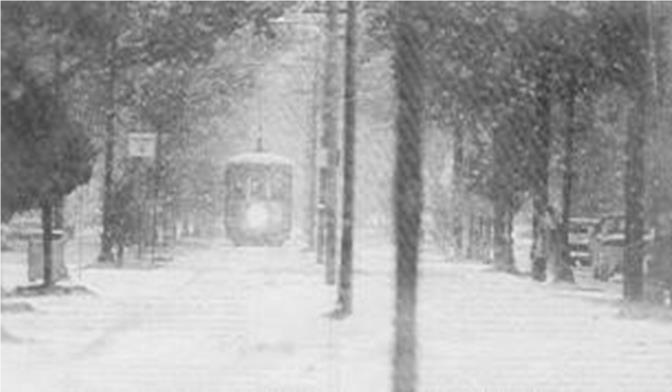 Source: National Weather Service – New Orleans / Baton Rouge Office
Source: National Weather Service – New Orleans / Baton Rouge Office
On January 12, 1997, a record ice storm hit southern Louisiana and New Orleans. Thousands of customers were without electric power for up to six days due to downed trees and power lines from the wind. Numerous traffic accidents were attributed to icy roadways. Tons of debris were removed, and numerous homes received minor roof damage due to trees and tree limbs falling on them.
In addition to these more severe events, the City experienced a snow event on December 11, 2008, when about two inches of snow fell, with accumulations mainly in grassy areas. There were about 7,000 power outages Statewide, but the New Orleans area was spared any significant effects, except school, office, and some road/bridge closures. After the snowfall, the weather changed to freezing rain and sleet, which compounded the traffic and driving problems. Fortunately, the weather warmed up significantly the following day, so there were few lasting effects from the event. The following provides a summary of winter storm events.
Table 32: Winter Storm Events, Orleans Parish, 1962 – 2019
| Year |
Property Damage Amount |
Occurrences |
| 1962 |
$781,251 |
2 |
| 1963 |
$1,172 |
3 |
| 1965 |
$0 |
1 |
| 1971 |
$781 |
1 |
| 1973 |
$7,813 |
1 |
| 1976 |
$0 |
1 |
| 1977 |
$80,723 |
2 |
| 1982 |
$7,812 |
1 |
| 1983 |
$78,125 |
1 |
| 1985 |
$781 |
1 |
| 1989 |
$7,813 |
1 |
| 1993 |
$0 |
1 |
| 1996 |
$0 |
1 |
| 2008 |
$0 |
1 |
| 2018 |
$0 |
1 |
Source: NOAA, Spatial Hazard Events and Losses Database for the U.S. (SHELDUS)
Table 33: Winter storm events in Orleans Parish since 1996
| Date |
Event Type |
Direct Deaths |
Summary |
| 2/2/1996 |
Cold/Wind Chill |
0 |
An arctic airmass overspread much of SE Louisiana bringing the longest extended period of cold weather since 1989. The 16-degree reading at Moisant International Airport also established a record minimum temperature for the month. The temperature at the Baton Rouge Airport remained below freezing for 68 consecutive hours. |
| 12/18/1996 |
Cold/Wind Chill |
0 |
The parishes west and north of Lake Pontchartrain experienced four nights of freezing temperatures with lowest readings for the period in the mid-teens. The parishes south of the Lake experienced a two to three-night freeze event with lowest readings in the mid-20s. Record minimum temperatures of 26 and 25 degrees were established at Moisant International Airport in New Orleans. |
| 12/15/2004 |
Winter Storm |
0 |
A dusting of snow and sleet to one half inch of accumulation across much of east central and southeast Louisiana. The heaviest sleet and snow accumulation occurred south of New Orleans where one half to one inch was observed. While amounts were not heavy, accumulation of winter precipitation in extreme southeast Louisiana is very unusual and resulted in considerable transportation problems. Many bridges, overpasses, and other elevated roadways become icy which resulted in some traffic accidents, and many of the elevated roadways were closed due to icing. New Orleans Armstrong International Airport was also closed for several hours due to icing conditions. |
| 1/3/2008 |
Cold/Wind Chill |
2 |
Overnight lows in the area were in the upper 20s. |
| 1/24/2014 |
Winter Weather |
0 |
A combination of freezing rain, sleet and snow fell across southeast Louisiana. Although amounts of the freezing and frozen precipitation generally remained below one quarter inch liquid equivalent, the precipitation produced very hazardous road conditions. Especially affected were bridges, overpasses and other elevated roadways. Travel was especially impacted in the Baton Rouge area with much of the interstate system shut down. |
| 1/17/2018 |
Winter Weather |
0 |
Air behind a strong arctic cold front changed precipitation from rain to freezing rain and snow across portions of the area to the north of Interstate 10. The Arctic airmass that spread into the region behind the front brought some of the coldest temperatures to the region in the past 10 years. Low temperatures on the morning of the 17th ranged from the mid-teens in interior parts of southeast Louisiana to low and mid 20s along in coastal area. Record low temperatures on the Jan 17th included 20 degrees at New Orleans International Airport and 14 degrees at Baton Rouge Airport. Due to unusually cold temperatures and bursting of water pipes occurred in many locations in coastal parishes, especially elevated houses. |
Source: NOAA Storm Events Database
On average, New Orleans experienced 13.5 days with temperatures below 40 degrees between 2010 to 2019. During this period of 10 years, there were four years that had had more days than average for the timeframe as demonstrated below.
Figure 40: Number of Days of Temperature Less than 40°F
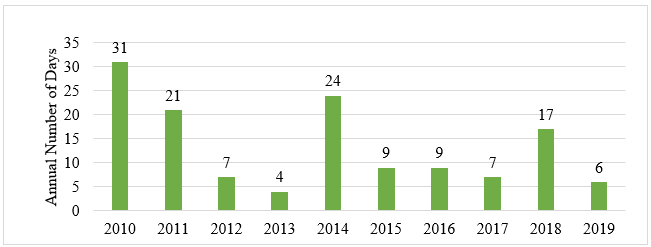 Source: Southern Regional Climate Center, August 2020
Source: Southern Regional Climate Center, August 2020
The following figure provides the number of City of New Orleans Freeze Plan activation days from 2013 to 2019. During that time, there was an average of eight New Orleans Freeze Plan activation days. When a Citywide Freeze Plan is activated, shelters for the homeless are opened free of charge to offer temporary overnight shelter.
Figure 41: New Orleans Freeze Plan Activation Days
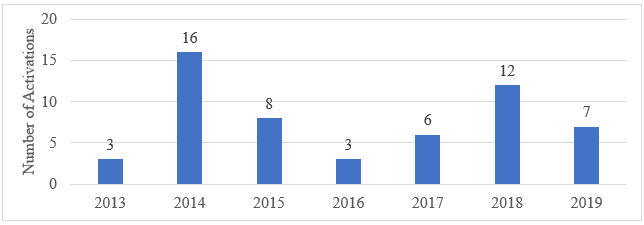 Source: New Orleans Health Department, August 2020
Source: New Orleans Health Department, August 2020
Hazard Impacts
Impact on Life and Property
In New Orleans, where the climate is subtropical, severe winter storms are rare and pose a minimal threat to life and property. Other risk factors such as homelessness and substandard housing increase exposure to winter weather and increase health risks. Also, the improper use of space heaters and poorly maintained heating systems can create a fire and/or carbon monoxide hazard, potentially resulting in injuries and fatalities. The NCEI database shows no injuries, deaths, or property damage from winter storms between 1950 and 2020 in New Orleans. There are occasional highway accidents and broken pipes related to freezing and ice, but these are not reported in any public database and cannot be readily related to specific events.
Long periods of freezing temperatures can impact the infrastructure of the City of New Orleans and other jurisdictions within the parish as well. If multiple pipes burst, pressure in the water distribution system can impact businesses and residents. If severe enough, low pressure may lead to a boil water advisory, as occurred in January 2018. The need to “drip” pipes puts a large burden on SWBNO water plants and has an environmental impact in terms of energy use and greenhouse gas emission.
Heavily populated areas are particularly impacted when severe winter storms disrupt communication and power due to downed lines from high winds and icing. Debris associated with heavy icing may impact utility systems and transportation routes. Interruptions to daily affairs have a high aggregate cost in lost household incomes, lost tax revenue, and public safety response to close roads and provide essential services.
The potential impacts on the Human Environment include CO2 poisoning and fire hazards due to substandard housing and the resultant use of ovens, space heaters, etc., for warmth. Additionally, any vulnerable populations, including persons experiencing homelessness, are in need of shelter during a winter storm event. The need for freeze shelters tends to be highest in years that there are multiple freeze events. However, demand for shelter was over 1,400 in 2016 over the course of three freeze plan activation days, averaging nearly 500 people a day.
Figure 42: Total Aggregated Population in Freeze Shelters
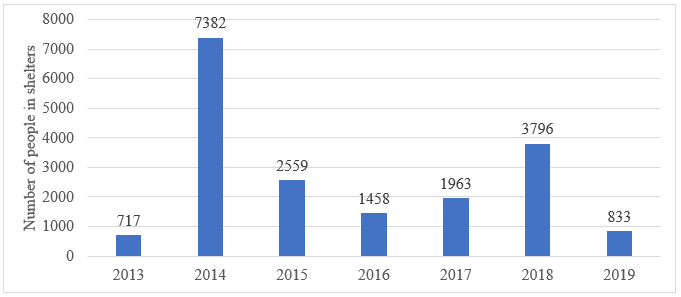 Source: New Orleans Health Department
Source: New Orleans Health Department
Figure 43: Average Annual Population of Freeze Shelters
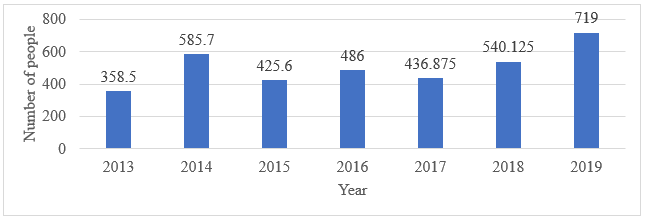 Source: New Orleans Health Department
Source: New Orleans Health Department
With respect to the natural environment: freezes can damage vegetation, including recently planted trees, and may impact ongoing efforts to increase canopy cover or establish constructed wetlands. Freezing temperatures may help control some pest species.
Vulnerability
Due to its geographic location in the southeastern part of the State, New Orleans is at annual probability for winter weather (Blizzard, Cold/Wind Chill, Freezing Fog, Frost/Freeze, Heavy Snow, Ice Storm) around 36%. This hazard has a very low probability of significant impacts on the Parish.
The Parish is not particularly vulnerable to the winter storm hazard. Although clearly there is always the potential for traffic accidents and interruptions to functions throughout the area, the most significant vulnerabilities to the winter storm hazards are typically failures of structures and infrastructure due to snow and ice loads. New Orleans is not subject to heavy snow or ice loads, and there is a minimal history of damages from this hazard. Thus, the Parish’s vulnerability to this hazard should be considered relatively low.
Relevant Actions
Hazard:
Tropical Cyclones, Coastal Erosion, Winter Weather |
Goal:
Goal 2: Reduce risk and vulnerability to the built environment including current and future structures; critical facilities; historic structures; and infrastructure, including communications infrastructure. |
Status:
|
Timeframe:
5-10 years |
Priority:
Medium |
2015 Priority:
Medium |
|
Lead Agencies:
City of New Orleans (Property Management), SWBNO |
Support Agencies:
|
Cost:
90000000 |
Funding source:
FEMA |
Emergency Support Function:
ESF 5 |
Comment on this action item
Hazard:
Extreme Heat, Winter Weather |
Goal:
Goal 1: Reduce risk and vulnerability to the human environment including cultural resources, homeowners, renters, visitors, and transient populations. |
Status:
|
Timeframe:
1-5 years |
Priority:
Medium |
2015 Priority:
N/A |
|
Lead Agencies:
CNO (Office of Community Development) |
Support Agencies:
|
Cost:
City Staff Time |
Funding source:
CNO General Fund, State and Federal Grants, Philanthropic Grants, Private Financing |
Emergency Support Function:
ESF 6 |
Comment on this action item
Hazard:
Flooding, Storm Surge, Tornadoes, Tropical Cyclones, Coastal Erosion, Subsidence, Severe Thunderstorms, Extreme Heat, Winter Weather |
Goal:
Goal 1: Reduce risk and vulnerability to the human environment including cultural resources, homeowners, renters, visitors, and transient populations. |
Status:
|
Timeframe:
1-3 years |
Priority:
Medium |
2015 Priority:
N/A |
|
Lead Agencies:
CNO (Office of Resilience & Sustainability) |
Support Agencies:
|
Cost:
City Staff Time |
Funding source:
CNO General Fund, State and Federal Grants, Philanthropic Grants |
Emergency Support Function:
ESF 14 |
Comment on this action item
Hazard:
Extreme Heat, Winter Weather, Infrastructure Failure (Power Outages) |
Goal:
Goal 2: Reduce risk and vulnerability to the built environment including current and future structures; critical facilities; historic structures; and infrastructure, including communications infrastructure. |
Status:
|
Timeframe:
1-5 years |
Priority:
High |
2015 Priority:
N/A |
|
Lead Agencies:
CNO (Office of Resilience & Sustainability) |
Support Agencies:
|
Cost:
City Staff Time |
Funding source:
CNO General Fund, State and Federal Grants, Philanthropic Grants, Private Financing |
Emergency Support Function:
ESF 12 |
Comment on this action item
Hazard:
Flooding, Tornadoes, Tropical Cyclones, Severe Thunderstorms, Winter Weather, Active Threats, Infrastructure Failure |
Goal:
Goal 2: Reduce risk and vulnerability to the built environment including current and future structures; critical facilities; historic structures; and infrastructure, including communications infrastructure. |
Status:
|
Timeframe:
2-5 years |
Priority:
Medium |
2015 Priority:
N/A |
|
Lead Agencies:
CNO (Office of Resilience & Sustainability) |
Support Agencies:
|
Cost:
City Staff Time, Contract Labor |
Funding source:
Homeland Security, FEMA, Health and Human Services |
Emergency Support Function:
ESF 2, ESF 4, ESF 6, ESF 8, ESF 10 |
Comment on this action item
Hazard:
Winter Weather, Infrastructure Failure |
Goal:
Goal 2: Reduce risk and vulnerability to the built environment including current and future structures; critical facilities; historic structures; and infrastructure, including communications infrastructure. |
Status:
|
Timeframe:
|
Priority:
Low |
2015 Priority:
N/A |
|
Lead Agencies:
CNO (Fire Department) |
Support Agencies:
|
Cost:
|
Funding source:
|
Emergency Support Function:
ESF 5 |
Comment on this action item
Hazard:
Extreme heat, Winter Weather |
Goal:
Goal 2: Reduce risk and vulnerability to the built environment including current and future structures; critical facilities; historic structures; and infrastructure, including communications infrastructure. |
Status:
|
Timeframe:
3-5 years |
Priority:
Medium |
2015 Priority:
N/A |
|
Lead Agencies:
CNO (City Planning Commission) |
Support Agencies:
|
Cost:
City Staff Time |
Funding source:
CNO General Fund |
Emergency Support Function:
ESF 12 |
Comment on this action item
Hazard:
Flooding, Tornadoes, Tropical Cyclones, Severe Thunderstorms, Extreme Heat, Subsidence, Winter Weather, Coastal Erosion, Infectious Disease Outbreak, Active Threats, Infrastructure Failure, Hazardous Materials, Economic Shock |
Goal:
Goal 4: Maximize the involvement of individuals, businesses, and groups in risk reduction measures through education/outreach on hazard mitigation appropriate to all groups, particularly vulnerable populations. |
Status:
|
Timeframe:
3-5 years |
Priority:
Medium |
2015 Priority:
N/A |
|
Lead Agencies:
CNO (Homeland Security & Emergency Preparedness) |
Support Agencies:
|
Cost:
City Staff Time, Contract Labor |
Funding source:
City capital bond funds, GOMESA, CDBG, CDBG-NDR, Sewerage and Water Board, State capital outlay, FHWA, FEMA-HMGP, US Army Corps of Engineers, FEMA |
Emergency Support Function:
ESF 1, ESF 3 |
Comment on this action item
Hazard:
Flooding, Storm Surge, Tornadoes, Tropical Cyclones Severe Thunderstorms, Extreme Heat, Winter Weather, Coastal Erosion, Subsidence |
Goal:
Goal 4: Maximize the involvement of individuals, businesses, and groups in risk reduction measures through education/outreach on hazard mitigation appropriate to all groups, particularly vulnerable populations. |
Status:
|
Timeframe:
4-5 years |
Priority:
Medium |
2015 Priority:
N/A |
|
Lead Agencies:
CNO (Office of Community Development) |
Support Agencies:
|
Cost:
City Staff Time, Contract Labor |
Funding source:
GOMESA, CPRA, CWPPRA, Sewerage and Water Board |
Emergency Support Function:
ESF 1, ESF 3 |
Comment on this action item
Hazard:
Flooding, Tornadoes, Tropical Cyclones, Severe Thunderstorms, Extreme Heat, Winter Weather, Coastal Erosion, Subsidence |
Goal:
Goal 4: Maximize the involvement of individuals, businesses, and groups in risk reduction measures through education/outreach on hazard mitigation appropriate to all groups, particularly vulnerable populations. |
Status:
|
Timeframe:
1-2 years |
Priority:
High |
2015 Priority:
N/A |
|
Lead Agencies:
CNO (Department of Public Works, Parks and Parkways) |
Support Agencies:
|
Cost:
City Staff Time, Contract Labor |
Funding source:
CNO General Fund, State and Federal Grants, Philanthropic Grants |
Emergency Support Function:
ESF 3, ESF 5 |
Comment on this action item
Hazard:
Flooding, Storm Surge, Tornadoes, Tropical Cyclones, Severe Thunderstorms, Extreme Heat, Subsidence, Winter Weather, Coastal Erosion, Infectious Disease Outbreak, Active Threats, Infrastructure Failure, Hazardous Materials, Economic Shock |
Goal:
Goal 4: Maximize the involvement of individuals, businesses, and groups in risk reduction measures through education/outreach on hazard mitigation appropriate to all groups, particularly vulnerable populations. |
Status:
|
Timeframe:
1-5 years |
Priority:
High |
2015 Priority:
N/A |
|
Lead Agencies:
CNO (Office of Resilience & Sustainability) |
Support Agencies:
|
Cost:
City Staff Time |
Funding source:
CNO General Fund, State and Federal Grants, Philanthropic Grants |
Emergency Support Function:
ESF 15 |
Comment on this action item
Hazard:
Flooding, Storm Surge, Tropical Cyclones, Coastal Erosion, Subsidence, Severe Thunderstorms, Extreme Heat, Winter Weather |
Goal:
Goal 4: Maximize the involvement of individuals, businesses, and groups in risk reduction measures through education/outreach on hazard mitigation appropriate to all groups, particularly vulnerable populations. |
Status:
|
Timeframe:
1-5 years |
Priority:
Medium |
2015 Priority:
N/A |
|
Lead Agencies:
CNO (Office of Resilience & Sustainability) |
Support Agencies:
|
Cost:
City Staff Time, Contract Labor |
Funding source:
CNO General Fund, State and Federal Grants, Philanthropic Grants |
Emergency Support Function:
ESF 5 |
Comment on this action item
Hazard:
Flooding, Tornadoes, Tropical Cyclones, Severe Thunderstorms, Extreme Heat, Subsidence, Winter Weather, Coastal Erosion, Infectious Disease Outbreak, Active Threats, Infrastructure Failure, Hazardous Materials, Economic Shock |
Goal:
Goal 4: Maximize the involvement of individuals, businesses, and groups in risk reduction measures through education/outreach on hazard mitigation appropriate to all groups, particularly vulnerable populations. |
Status:
|
Timeframe:
1-5 years |
Priority:
Medium |
2015 Priority:
N/A |
|
Lead Agencies:
CNO (Homeland Security & Emergency Preparedness) |
Support Agencies:
|
Cost:
City Staff Time |
Funding source:
State and Federal Grants |
Emergency Support Function:
ESF 5, ESF 7 |
Comment on this action item
Hazard:
Flooding, Storm Surge, Tornadoes, Tropical Cyclones, Severe Thunderstorms, Extreme Heat, Winter Weather |
Goal:
Goal 5: To promote, implement, and sustain mitigation measures in Orleans Parish in order to reduce and manage risks to human life, the environment, and property. |
Status:
|
Timeframe:
1-2 years |
Priority:
Medium |
2015 Priority:
N/A |
|
Lead Agencies:
CNO (Homeland Security & Emergency Preparedness) |
Support Agencies:
|
Cost:
City Staff Time |
Funding source:
CNO General Fund, State and Federal Grants |
Emergency Support Function:
ESF 5 |
Comment on this action item
Hazard:
Flooding, Tornadoes, Tropical Cyclones, Severe Thunderstorms, Extreme Heat, Winter Weather, Coastal Erosion, Subsidence |
Goal:
Goal 5: To promote, implement, and sustain mitigation measures in Orleans Parish in order to reduce and manage risks to human life, the environment, and property. |
Status:
|
Timeframe:
4-5 years |
Priority:
Medium |
2015 Priority:
N/A |
|
Lead Agencies:
CNO (Information Technology & Innovation) |
Support Agencies:
|
Cost:
City Staff Time, Contract Labor |
Funding source:
EPA, US Army Corps of Engineers, FEMA-HMGP |
Emergency Support Function:
ESF 8 |
Comment on this action item
Hazard:
Flooding, Tornadoes, Tropical Cyclones, Severe Thunderstorms, Extreme Heat, Winter Weather, Coastal Erosion, Subsidence |
Goal:
Goal 5: To promote, implement, and sustain mitigation measures in Orleans Parish in order to reduce and manage risks to human life, the environment, and property. |
Status:
|
Timeframe:
4-5 years |
Priority:
Medium |
2015 Priority:
|
|
Lead Agencies:
SWBNO |
Support Agencies:
|
Cost:
Staff Time, Contract Labor |
Funding source:
EPA, US Army Corps of Engineers, FEMA-HMGP |
Emergency Support Function:
ESF 8 |
Comment on this action item
Hazard:
Flooding, Tornadoes, Tropical Cyclones, Severe Thunderstorms, Extreme Heat, Winter Weather, Coastal Erosion, Subsidence |
Goal:
Goal 5: To promote, implement, and sustain mitigation measures in Orleans Parish in order to reduce and manage risks to human life, the environment, and property. |
Status:
|
Timeframe:
4-5 years |
Priority:
Medium |
2015 Priority:
|
|
Lead Agencies:
NORA |
Support Agencies:
|
Cost:
Staff Time, Contract Labor |
Funding source:
EPA, US Army Corps of Engineers, FEMA-HMGP |
Emergency Support Function:
ESF 8 |
Comment on this action item
Hazard:
Flooding, Tornadoes, Tropical Cyclones, Severe Thunderstorms, Extreme Heat, Winter Weather, Coastal Erosion, Subsidence |
Goal:
Goal 5: To promote, implement, and sustain mitigation measures in Orleans Parish in order to reduce and manage risks to human life, the environment, and property. |
Status:
|
Timeframe:
4-5 years |
Priority:
Medium |
2015 Priority:
|
|
Lead Agencies:
HANO |
Support Agencies:
|
Cost:
Staff Time, Contract Labor |
Funding source:
EPA, US Army Corps of Engineers, FEMA-HMGP |
Emergency Support Function:
ESF 8 |
Comment on this action item
Hazard:
Flooding, Tornadoes, Tropical Cyclones, Severe Thunderstorms, Extreme Heat, Winter Weather, Coastal Erosion, Subsidence |
Goal:
Goal 5: To promote, implement, and sustain mitigation measures in Orleans Parish in order to reduce and manage risks to human life, the environment, and property. |
Status:
|
Timeframe:
4-5 years |
Priority:
Medium |
2015 Priority:
|
|
Lead Agencies:
Tulane University |
Support Agencies:
|
Cost:
Staff Time, Contract Labor |
Funding source:
EPA, US Army Corps of Engineers, FEMA-HMGP |
Emergency Support Function:
ESF 8 |
Comment on this action item
Hazard:
Flooding, Tornadoes, Tropical Cyclones, Severe Thunderstorms, Extreme Heat, Winter Weather, Coastal Erosion, Subsidence |
Goal:
Goal 5: To promote, implement, and sustain mitigation measures in Orleans Parish in order to reduce and manage risks to human life, the environment, and property. |
Status:
|
Timeframe:
1-2 years |
Priority:
Medium |
2015 Priority:
N/A |
|
Lead Agencies:
CNO (Office of Resilience & Sustainability) |
Support Agencies:
|
Cost:
City Staff Time, Contract Labor |
Funding source:
Health and Human Services, CDC, EPA |
Emergency Support Function:
ESF 8, ESF 6 |
Comment on this action item
Hazard:
Flooding, Extreme Heat, Winter Weather, Tropical Cyclones |
Goal:
Goal 5: To promote, implement, and sustain mitigation measures in Orleans Parish in order to reduce and manage risks to human life, the environment, and property. |
Status:
|
Timeframe:
1-3 years |
Priority:
Low |
2015 Priority:
N/A |
|
Lead Agencies:
CNO (Department of Public Works, Office of Resilience & Sustainability) |
Support Agencies:
|
Cost:
City Staff Time |
Funding source:
CNO General Fund |
Emergency Support Function:
ESF 5 |
Comment on this action item
Hazard:
Flooding, Extreme Heat, Winter Weather, Tropical Cyclones, Severe Thunderstorms |
Goal:
Goal 5: To promote, implement, and sustain mitigation measures in Orleans Parish in order to reduce and manage risks to human life, the environment, and property. |
Status:
|
Timeframe:
1-3 years |
Priority:
Low |
2015 Priority:
|
|
Lead Agencies:
HANO |
Support Agencies:
|
Cost:
Staff Time |
Funding source:
TBD |
Emergency Support Function:
ESF 5 |
Comment on this action item
Hazard:
Flooding, Tornadoes, Tropical Cyclones, Severe Thunderstorms, Extreme Heat, Subsidence, Winter Weather, Coastal Erosion, Infectious Disease Outbreak, Active Threats, Infrastructure Failure, Hazardous Materials, Economic Shock |
Goal:
Goal 6: To protect Orleans Parish and the surrounding region from the effects of natural and manmade hazards, ensuring community continuity in the event of such hazards. |
Status:
|
Timeframe:
3-5 years |
Priority:
Medium |
2015 Priority:
N/A |
|
Lead Agencies:
CNO (Office of Resilience & Sustainability, Neighborhood Engagement Office) |
Support Agencies:
|
Cost:
City Staff Time |
Funding source:
CNO General Fund, State and Federal Grants, Philanthropic Grants |
Emergency Support Function:
ESF 7, ESF 14 |
Comment on this action item
Hazard:
Flooding, Tornadoes, Tropical Cyclones, Severe Thunderstorms, Extreme Heat, Subsidence, Winter Weather, Coastal Erosion, Infectious Disease Outbreak, Active Threats, Infrastructure Failure, Hazardous Materials, Economic Shock |
Goal:
Goal 6: To protect Orleans Parish and the surrounding region from the effects of natural and manmade hazards, ensuring community continuity in the event of such hazards. |
Status:
|
Timeframe:
1-5 years |
Priority:
Medium |
2015 Priority:
|
|
Lead Agencies:
HANO |
Support Agencies:
|
Cost:
TBD |
Funding source:
TBD |
Emergency Support Function:
|
Comment on this action item
Hazard:
All |
Goal:
Goal 2: Reduce risk and vulnerability to the built environment including current and future structures; critical facilities; historic structures; and infrastructure, including communications infrastructure. |
Status:
|
Timeframe:
TBD |
Priority:
Medium |
2015 Priority:
N/A |
|
Lead Agencies:
SWBNO Emergency Mgmt |
Support Agencies:
|
Cost:
21000000 |
Funding source:
PDM/SWBNO |
Emergency Support Function:
ESF 6 |
Comment on this action item
Hazard:
Flooding,Storm Surge,Tropical Cyclones,Tornadoes,Subsidence,Winter Weather,Extreme Heat,Severe Thunderstorms |
Goal:
Goal 2: Reduce risk and vulnerability to the built environment including current and future structures; critical facilities; historic structures; and infrastructure, including communications infrastructure.
|
Status:
|
Timeframe:
On Going |
Priority:
High |
2015 Priority:
|
|
Lead Agencies:
Tulane University (Office of Risk Management) |
Support Agencies:
|
Cost:
Cost will be project specific |
Funding source:
GOHSEP; FEMA |
Emergency Support Function:
ESF 3 |
Comment on this action item
Hazard:
Flooding,Tropical Cyclones,Coastal Erosion,Tornadoes,Subsidence,Winter Weather,Extreme Heat,Severe Thunderstorms |
Goal:
Goal 2: Reduce risk and vulnerability to the built environment including current and future structures; critical facilities; historic structures; and infrastructure, including communications infrastructure.
|
Status:
|
Timeframe:
1 year |
Priority:
High |
2015 Priority:
|
|
Lead Agencies:
Tulane University (Office of Capital Projects and Real Estate) |
Support Agencies:
|
Cost:
Staff Time and Data Costs |
Funding source:
NOAA; USGS; NOAA; FEMA; TDEM; DOT; DHS; EPA; GOHSEP |
Emergency Support Function:
|
Comment on this action item
Leave a Comment